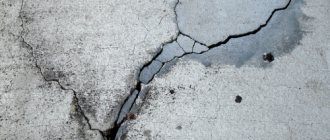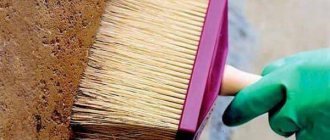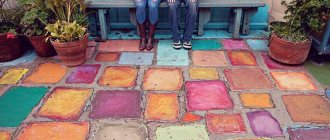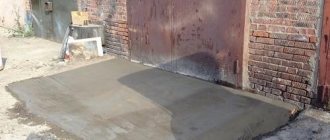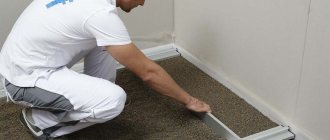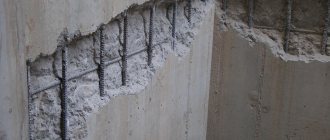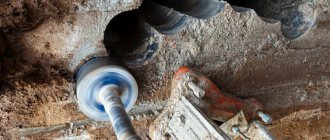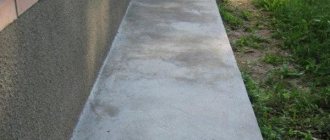When carrying out repairs or general construction work, it is impossible to do without splashes on unprotected surfaces when stirring or applying cement mortar. No one is safe from spilling the mixture on the floor. This disaster is fixable thanks to modern chemical means. The issue can be resolved simply after purchasing a solvent for cement.
Composition and principle of action of solvents for concrete
Concrete is one of the few substances that have excellent adhesion to metal. This means that dried cement mortar will be very difficult to remove, but not impossible. All concrete solvents contain :
- concentrated acid;
- inhibitors;
- substances that perform protective properties.
It is the concentrated acid in the concrete solvent that has the desired effect - it literally corrodes the cement mortar. The principle of operation of the agents in question is to dissolve concrete with acid and penetrate it into the deep layers of dried cement mortar.
What does a person see when applying solvent to a contaminated tool/surface?:
- the solvent begins to foam on the surface;
- dried cement mortar turns into mush.
The resulting slurry is easily washed off with a stream of water, and the result is an absolutely clean surface.
Dismantling of reinforced structures
Reinforced concrete is much more difficult to destroy than a regular monolith, since it is reinforced with steel reinforcement. It has to be sawed with a grinder with special discs. To destroy large objects, you cannot do without specialized equipment that cuts the entire structure with a diamond wire or disk.
Diamond cutting with professional tools Source premium-instrument.ru
If the thickness of reinforced concrete does not exceed half a meter, you can get by using the methods described above, breaking out pieces of concrete and cutting the reinforcement with hand-held power tools.
Characteristics of solvents for concrete
There are several types of the material in question on the market, which have their own distinctive characteristics. But there are also common characteristics :
- Concrete solvents are safe for humans and can be used indoors - these products do not release toxic/toxic substances into the air;
- all types of solvents for cement mortar are fireproof - do not burn, do not support combustion;
- the product in question does not damage paint and varnishes - they can be used to clean contaminated decorative surfaces;
- Solvents have a pungent odor, but they do not affect the mucous membrane of the human respiratory tract;
- You don’t have to worry about the product getting on the ground – over time it will completely dissolve, without having time to harm the organic composition of the soil.
Any type of cement mortar solvent is sold in cans or spray bottles. It can be dissolved or concentrated, but experts recommend purchasing the concentrated substance. This solution will make it possible to independently prepare a solution of the required concentration for cleaning contaminated surfaces. Remember the following :
- It is better to remove very old stains of cement mortar with a concentrated solution without any dilution;
- if it is necessary to remove fresh concrete that has only slightly hardened, then the product should be diluted in a ratio of 1:3;
- lime mortar is removed from tools and any surfaces with a solution in a ratio of 1:5;
- if you just need to clean construction/repair tools, you can dilute concrete solvent in a ratio of 1:10 and simply wash them.
Please note: the substance in question may change the color of some products, although this only applies to low-quality decorative coatings. Therefore, before large-scale use of concrete solvents, professionals check its reliability on a small fragment of a dirty product.
What tools will you need?
To remove cement stains, you need more than just chemicals. Since the mixture can dry strongly to the surface, you will need to somehow act on the stain mechanically.
You will need:
- bucket;
- towels;
- fleece and cotton rags;
- sponges of varying hardness;
- plastic scrapers and spatulas;
- latex gloves.
Please note that the use of metal scrapers may have a detrimental effect on the quality of the surface after cleaning. Tools can damage plastic, glass and other coatings.
Overview of solvents for concrete
There is a fairly large assortment of the product in question on the market, but there are several brands of solvents that are most popular among consumers.
Himfrez
This solvent does not contain acetic, otophosphoric or hydrochloric acid - this characteristic allows Himfrez to be used for cleaning decorative coatings, since neither the design nor the color itself will be damaged.
If you use a solvent to get rid of dried cement mortar on brickwork, you should consider:
- Himfrez opens microcracks in bricks, which has a beneficial effect on the result of subsequent waterproofing work;
- This type of product eliminates efflorescence - a white coating that appears on brickwork.
The advantage of this particular solvent is that Himfrez can be used simultaneously with manual/mechanical cleaning and sandblasting. Work to remove hardened cement mortar using Himfrez can be carried out at temperatures of +5 and above.
Barracuda
This brand of solvent also has its own distinctive features:
the composition does not contain acid and therefore can be used for work on any surface;- absolutely safe for humans - Barracuda does not have a negative effect on the mucous membranes and skin of humans;
- can remove dried tile adhesive, efflorescence on brickwork, lime deposits;
- does not spoil varnish and decorative paint coatings;
- can remain on the surface for a long time after application - nothing will happen to the base material;
- if metal objects/structures are processed, then you don’t have to worry about the appearance of corrosion;
- environmentally friendly solvent - completely dissolves without harming the organic layer of the soil.
Lugato
This concrete solvent contains acid, so it should be used with extreme caution and not on all surfaces. It is strictly forbidden to treat marble and terrazzo surfaces with it, but Lugato will effectively and quickly remove even long-dried cement mortar from the surface of plumbing fixtures and unglazed ceramics.
Please note : this solvent can be used to treat chrome-plated products - the coating will remain intact.
BIO DECAP'BETON GUARD
Can be used on glass, plastic and metal surfaces. BIO DECAP'BETON GUARD acts as a surface cleaner, but can be used to remove fresh dirt and old stains from cement mortar.
The solvent in question for cement mortar is absolutely safe for the environment - it dissolves almost completely.
Down with the consequences of repairs, or How to clean linoleum after it
Reading time: 4 minutes No time?
We will send the material to you by e-mail
The popularity of linoleum as a floor covering is due to its wear resistance, relatively low price, aesthetic appearance and ease of maintenance. But any repair can turn even the most unpretentious linoleum into a field after a military battle. To avoid damage to the floor covering, the editors of HomeMyHome.ru have prepared several working tips on how to clean linoleum after renovation.
The flooring needs care, otherwise it will soon need to be replaced, so you need to know how to wash linoleum
How to clean linoleum from ingrained dirt after repairs
Even if you cover the linoleum with polyethylene or newspapers, after the repair, stains from cement, polyurethane foam or paint still remain in places. Yes, and you will need to wash it off with construction dust in any case. For complete, high-quality floor cleaning, you can use specialized products or use recommended folk remedies.
How to clean linoleum from dirt from household chemicals
Linoleum becomes dirty not only after renovation, but also after active work in the kitchen. After some time, you may notice that the relin looks untidy and requires cleaning: you need to know what to wash it with.
How to clean linoleum in the kitchen? A whole range of means!
First, let's figure out which chemicals should not be used: bleaching concentrates such as kerosene, ammonia, gasoline, turpentine, soda. It is better to use these aggressive preparations in another place or, if necessary, in a targeted manner, for example, to wipe off an oil stain, use a little gasoline, immediately washing it off with water.
Not all housewives know how to clean linoleum from dirt using suitable means. There are a number of substances suitable for rubber flooring. Such products include drying oil. It easily helps remove dirt, helps restore the color of the canvas, and prevents the appearance of cracks.
Drying oil - hello, clean shining floor!
Relin is rubbed with drying oil and polished with a silk cloth. The procedure must be performed once every 3-4 months. Floor products like Mister Proper or Mister Muscle are suitable for many surfaces. In order not to spoil the canvas, you need to select the concentration according to the instructions on the package.
How to clean linoleum from stubborn dirt according to folk recipes
What folk remedies can you use to clean linoleum in the kitchen? Due to the nature of the coating, the best cleaning agent is a non-alkaline soap solution. You can take regular bath soap and make a warm soapy solution.
Wet cleaning of the floor should be carried out daily
If the question arises about how to wash very dirty linoleum, then add a little vodka to the soap solution.
Soap solution and vodka are suitable for light-colored linoleum in the kitchen. The more often you wash away stains and grease, the longer the coating will last.
Another way: you can take dishwashing detergent, drop a few drops into a liter of water and add 200 g of vodka to the solution. This will perfectly refresh the floor covering. Few people know, but the best way to make homemade relin shine is linseed oil. It is applied with a sponge and rubbed with a soft cloth until the floor is dry.
Related article:
How to wash windows quickly and without streaks. Where stains on glass come from, folk remedies, household chemicals, procedure algorithm, necessary tools and devices - read in the publication.
How to clean an apartment after renovation from specific contaminants
After repairs, various types of specific contaminants remain. You need to choose an effective linoleum cleaner for each case.
How to clean linoleum from lime and cement
How to wash linoleum if it is stained with lime or cement dust? This issue must be resolved immediately upon completion of the repair if such a problem arises.
A dirty looking floor covering is unlikely to lift the mood of the home owners
Lime or cement always makes relin look dull and feel rough to the touch. We wash the floor like this: first use warm water with a small amount of dishwashing detergent. A tablespoon is enough for a bucket of water. Then we wash the floor with a saline solution: for 10 liters of water you need to take half a glass of salt. If the dirt has not been completely removed, you can add 100 ml of vinegar to the salt water. All that remains is to complete the cleaning by wiping the floor with clean water. If the cement is ingrained, you will need to dilute 100 g of kerosene in a bucket of water. The coating is washed with water and vinegar a second time to remove the odor.
How to work with cement solvents correctly
Important: concrete solvents contain organic acids and therefore, before working with them, you should wear gloves, safety glasses and a respirator, and create a draft in the room for active ventilation.
Rules for the safe use of the product in question:
- the surface on which work will be carried out with the solvent is cleaned of debris/dirt and large fragments of dried cement mortar;
- the solvent is either applied to the product with a wide brush or sprayed - the second method is preferable;
- after the time specified in the instructions for the product, the resulting foam is washed off with a stream of water and, if necessary, the surface is cleaned with a brush;
- the procedure is repeated only if the cement mortar is not completely dissolved the first time.
Reducing the concrete layer
Sometimes builders have to reduce the thickness of the concrete layer, for example, screed. Because of this, furniture or some kind of structure may not fit. Therefore, you have to trim the concrete screed. To make the concrete thinner, for example, by two centimeters, you should use an attachment designed for a grinding machine. With its help, the size of special disks is reduced. Before cutting it must be soaked with water. Water will help clean it of dust and debris. When soaking with water, you need to remember to follow safety precautions.
Return to contents
How to remove dried concrete using home methods
Of course, it is very convenient to use special solvents to get rid of dried cement mortar. But very often there is no opportunity to purchase the products in question, and then you can resort to homemade cleaning products.
Manual/mechanical method
Dried cement mortar can also be removed mechanically: with a chisel, hammer, spatula, sandpaper. These tools can be used to clean, for example, tiles in the event of intended secondary use. To obtain the expected result, it is necessary to fix the tile vertically (elementary - clamp it in a vice) and by placing a chisel at an angle to the place of contamination, you can apply blows of medium intensity. In this way, large fragments of dried concrete will be removed, and final cleaning should be done with sandpaper.
Please note: if you want to get rid of dried concrete faster and easier, then experts recommend soaking the tiles in water first - in this case, you can remove the cement mortar with a spatula.
Very often, to clean surfaces, amateurs use a grinder or a drill with a special “petal” sanding attachment - this is permissible, but only on large areas of the surface to be cleaned and on durable contaminated material.
Chemical method
At home, you can use sulfuric acid - it is diluted with water in a ratio of 1:10 and heated in a cast-iron bowl. Objects that need to be cleaned of cement are dipped into diluted and heated sulfuric acid - they will become clean quickly enough.
Important: the method of removing concrete using sulfuric acid is dangerous for humans, so both experts and doctors do not recommend its use.
An alkaline solution from old car batteries will help to perform the described procedure much easier and safer. Using a rag soaked in the solution, wipe the dried concrete and after 15-20 minutes it will be possible to remove the remaining cement mortar. Hydrochloric acid also works.
Remember that when working with such aggressive liquids you only need to wear thick rubber gloves, a respirator and goggles.
Removing concrete from carpets and textiles
It is clear that there is no need to remove dried cement mortar from textiles with vinegar or a grinder/sandpaper - the result will be a damaged item. But you can use the following methods :
- Using a stain remover. This product is sold in hardware stores, is inexpensive and can remove concrete from textiles only in cases of minor contamination. It is necessary to moisten a sponge with stain remover, apply it to the dirty area and press for several minutes. If the stain of dried concrete is large, then with the same sponge you should use the same sponge to wash away the dirt from the center to the edges of the product.
- Specific remedy. You need to mix ¼ part dishwashing liquid from a liter bottle and 250 ml of warm water. Then the solution is thoroughly mixed and applied to the stain with a stiff brush. As a rule, after 15 minutes it will be possible to remove the remaining fragments of cement mortar and send the product for washing in hot water.
- Vinegar, acetone or alcohol. It is necessary to moisten a sponge in one of the listed products, apply it to the dirty area and cover tightly with polyethylene. After 30 minutes, remove the “compress” and clean the textiles from the soaked concrete.
Solvents for cement mortar show excellent results - many have long stopped worrying about “hopelessly” damaged surfaces. It is only important to choose a product that will not spoil the contaminated product.
( 75 votes, average: 4.65 out of 5)
Calculation of the number of wallpapers
Terrace boards - types, characteristics, do-it-yourself installation
Related Posts
Preparatory work
A thick layer of frozen material is pre-wetted and subjected to mechanical removal. Tools for work:
- hammer;
- chisel;
- putty knife;
- chisel;
- Sander;
- sandpaper.
On fragile surfaces (ceramics, wood, plastic), work must be carried out with caution, avoiding irreparable damage. It is better to carry out translational movements of the tool along the surface, removing the top layers of cement.
Sandpaper will come in handy at the finishing stage of work or when removing small dirt. If the base is fragile, it is better to clean only chemically with a concentrated or ready-to-use concrete remover.
Briefly about the main thing
Concrete can be destroyed in different ways. If you have enough strength and are not afraid of dirt and noise, a mechanical one using impact tools - a hammer drill, a sledgehammer, a jackhammer - will do. You can avoid concrete dust settling in all corners of the house by renting hydraulic equipment - a wedge or scissors. But the most effective and least labor-intensive technologies are considered to be “silent explosion”, when concrete bursts due to bursting loads created by frozen water, swollen wooden wedges, or an expanding chemical.
